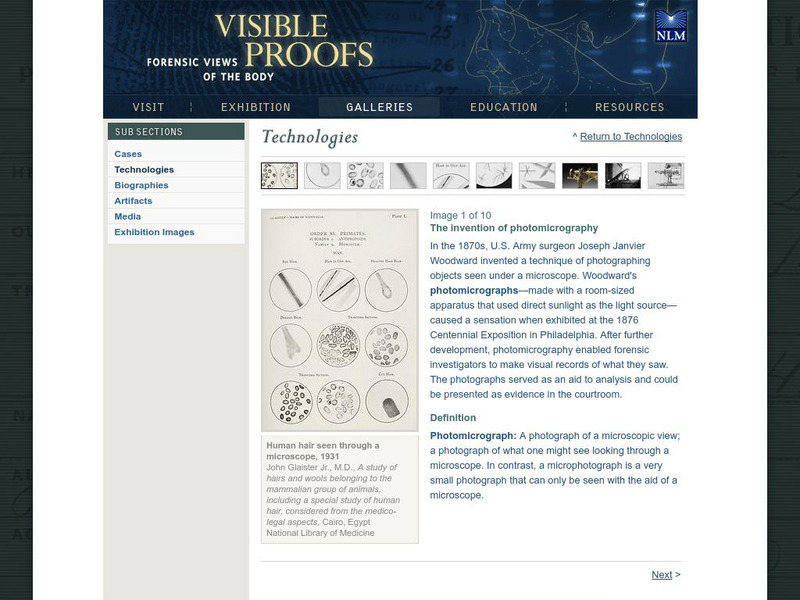Hi, what do you want to do?
Curated OER
Murder the Result of Various Injuries, 1898
In the 19th century, forensic pathologists began to use words and pictures to describe cadavers and to teach using cadavers in the classroom. See a number of interesting photos of various crime scenes on this interesting site.
National Institutes of Health
National Library of Medicine: Spectral Detection
This concise site provides a brief discussion of the invention of the first work spectroscopes and their impact on forensic science.
National Institutes of Health
National Library of Medicine: Virtopsy, the Virtual Autopsy
An interesting site that delves into how forensic scientists perform minimally invasive autopsies using state of the art technology.
National Institutes of Health
National Library of Medicine: The Invention of Photomicrography
The technique of photographing objects observed under a microscope is discussed in this succinct site. Various pictures taken under a microscope are displayed on this site as well.
National Institutes of Health
National Library of Medicine: Reading Gunshot Patterns
Various pictures of parts of the human anatomy showing gun shot trauma are found on this interesting site. .
National Institutes of Health
National Library of Medicine: Entomology in Action
Two lesson plans are found in this site. Lesson Plan 1 is geared to grades 6-9. In this plan, student's will be able to list the different stages of the blow fly's life cycle and understand how the life cycle and ADH (accumulated degree...
National Institutes of Health
National Library of Medicine: Dna a Molecular Identity
In this lesson plan site, students learn about DNA and examine three different situations where DNA was used to solve a case.
National Institutes of Health
National Library of Medicine: Key Accomplishments, Dna
A brief history of the major discoveries related to DNA from 1865 until 1991. Pictures of the responsible reponsibile for these key accomplishments are included as well.
PBS
Pbs: What Jennifer Saw
How can eyewitness identification go wrong? What role can DNA play in protecting the innocent? This interesting site answers these questions and gets the opinions of several DNA experts on this fascinating subject.
PBS
Pbs: Interview With Jim Liebman, Constitutional Law Professor at Columbia Univ.
Does innocence matter in our criminal justice system? Don't the DNA cases show that we are not getting the right outcome in more cases than we previously thought?
National Institutes of Health
National Library of Medicine: The Marsh Test
The Marsh Test, developed in 1832, was designed to detect poison in drinks. A short history of this test is provided along with photo of the test apparatus.
National Institutes of Health
National Library of Medicine: Key Accomplishments, Radiology
A history of radiology is featured from 1901 until 2003. Succinct paragraphs cover the highlights of each discvery.
National Institutes of Health
National Library of Medicine: Key Accomplishments, Toxicology
The history of toxicology is discussed from 1702 through 1966. Explanations of major discoveries are brief and to the point.
PBS
Pbs: Interview With Bennett Gershman, Former Prosecutor
Why does the criminal justice system resist reopening cases based on new DNA evidence? This former prosecutor sheds light on the answer in this informative interview.


















